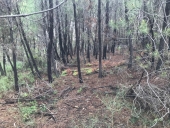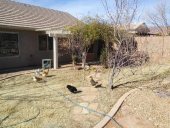
 1
1





 2
2




Living in Anjou , France,
For the many not for the few
http://www.permies.com/t/80/31583/projects/Permie-Pennies-France#330873








Permaculture...picking the lock back to Eden since 1978.
Pics of my Forest Garden




 4
4




Permaculture...picking the lock back to Eden since 1978.
Pics of my Forest Garden





Guilherme Weishar wrote:Hello!
I love reading this forum so I am happy to create my first thead.
My question is what to do with 3 invasive species that have overrun a property near the dunes, in Sintra Portugal.
So the main invasive species are the following:
Acacia longifolia
Arundo donax
Carpobrotus edulis
The initial plan is to ring bark the Acacia trees and cut the giant reed (knowing that they will just regrow if you do not remove the roots as well).
We also talked about covering the cut giant reed with a thick sheet of black plastic to kill the roots. The ice plant (Carpobrotus ebulis) is going to be the biggest challenge because of the area coverage. The strategy for this one will be to pull the plant with the roots out of the ground.
The end goal is to then introduce native dune species instead. But at the moment these 3 species out compete everything else.
I am putting my question here because I would like to see if there is a more permaculture way of dealing with this issue other then just physical removal of the plants.
I remember reading an article about invasive species where it was stated that the best way is to understand the soil conditions that these particular species thrive in and then change it so that they cannot survive.
My issue with this is that I do not know how to change the soil to kill these species AND allow other native species to thrive .
Thanks in advance and happy holidays to all
List of Bryant RedHawk's Epic Soil Series Threads We love visitors, that's why we live in a secluded cabin deep in the woods. "Buzzard's Roost (Asnikiye Heca) Farm." Promoting permaculture to save our planet.
 3
3




Medicinal herbs, kitchen herbs, perennial edibles and berries: https://mountainherbs.net/ grown in the Blue Mountains, Australia

 4
4














 2
2




 1
1





 3
3





 1
1








Living in Anjou , France,
For the many not for the few
http://www.permies.com/t/80/31583/projects/Permie-Pennies-France#330873
 1
1




Moderator, Treatment Free Beekeepers group on Facebook.
https://www.facebook.com/groups/treatmentfreebeekeepers/





 1
1









Guilherme Weishar wrote:... he says we could create new soil by progressive mulching over years. To create 1 inch of soil it takes about 10 years and this is with consistent mulching through out the year. So I am not sure if this is realistic, maybe somebody has some experience in recovering very degraded soil?
Works at a residential alternative high school in the Himalayas SECMOL.org . "Back home" is Cape Cod, E Coast USA.

|
Holly was looking awful sad. I gave her this tiny ad to cheer her up!
2024 Permaculture Adventure Bundle (now a special for october 2025)
https://permies.com/w/bundle
|





